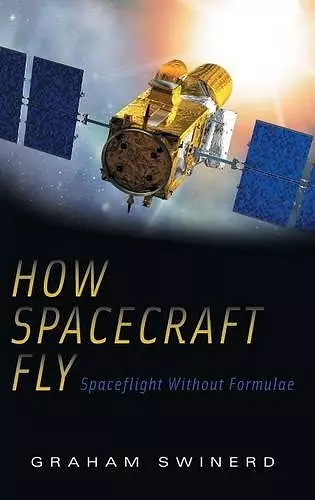How Spacecraft Fly
Spaceflight Without Formulae
Format:Hardback
Publisher:Springer-Verlag New York Inc.
Published:20th Oct '08
Should be back in stock very soon

The aim of this popular science text is to explain aerodynamic and astrodynamic flight without the use of mathematics, in an informal style, for non-technical readers who are interested in spaceflight and spacecraft.
The book will open with a concise introductory chapter, chronicling the ‘space age’ up to the present, and a brief ‘forward look’ into near-future developments. Chapter 2 provides the historical context upon which the current developments in spaceflight have been built. Orbital motion will be introduced in Chapter 3, and how to get there using launch vehicles is addressed in Chapter 4. Chapters 5 and 6 look at how spacecraft are designed, and Chapter 7 addresses the additional design constraints imposed if the spacecraft has a human crew on board. Chapter 8 gives examples of current and proposed spacecraft missions, both Earth orbiting and interplanetary. Chapter 9 will look at near future manned flight developments – for example, a mission to Mars and/or space tourism. The book closes with a concluding chapter, which reflects on prospects for the future of robotic and manned space exploration.
From the reviews:
"Fortunately Graham Swinerd, reader in astronautics at the University of Southampton, has penned... a maths-free guidebook... if only all popular science books were as clearly presented!" (Four out of five stars, Sean Blair, Sky at Night Magazine, May 2009)
"There is a great deal of useful information that you do not find readily elsewhere and given the rather dry nature of the subject, the book is written in a lucid and engaging style that makes enjoyable reading..." (Robin Flegg, Astronomy Now, May 2009)
"Aimed at non-technical readers, the book requires ‘no prior knowledge’. … The core of the book includes discussion of the various spacecraft subsystems, such as power, propulsion and communications, and a commentary on design. … The book makes reference to ‘Star Trek’, warp drive and the space elevator, but only by way of populist garnish." (Mark Williamson, IET Knowledge Network, May, 2009)
"This work is a basic introduction to spacecraft (mainly satellite) engineering … . The material in this volume should be accessible to any undergraduate who has taken introductory courses in math and physics. … This work is so fundamental and relevant to the modern world that it will be important for all libraries serving undergraduates. Summing Up: Highly recommended. General readers, lower- and upper-division undergraduates, graduate students, and two-year technical program students." (A. M. Strauss, Choice, Vol. 46 (8), April, 2009)
"The book concentrates on fundamental topics such as types of orbits, forces influencing orbits … and the multitude of systems and subsystems associated with spacecraft design. … This is certainly an interesting and highly readable volume which offers one of the best introductions to spacecraft engineering … . In conclusion, the author expresses the hope ‘that this book will play a … part in inspiring young people to get involved in space science and engineering’ — a hope that I heartily endorse." (Peter Bond, The Observatory, Vol. 129 (1212), October, 2009)
“The challenge of making rocketry and spaceflight understandable to the layman is … addressed by Professor Swinerd in this new and attractively produced book. … Written in a friendly style and extensively illustrated with images and graphics the book is well structured and indexed. … For the non specialist, as well as the non technical, this is a novel and interesting starting point for an armchair journey into space.” (Pat Norris, The Aeronautical Journal, July, 2ISBN: 9780387765716
Dimensions: unknown
Weight: unknown
272 pages
2009 ed.